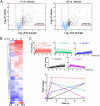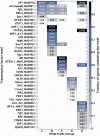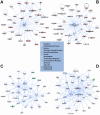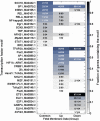Inflammatory gene regulatory networks in amnion cells following cytokine stimulation: translational systems approach to modeling human parturition
- PMID: 21655103
- PMCID: PMC3107214
- DOI: 10.1371/journal.pone.0020560
Inflammatory gene regulatory networks in amnion cells following cytokine stimulation: translational systems approach to modeling human parturition
Abstract
A majority of the studies examining the molecular regulation of human labor have been conducted using single gene approaches. While the technology to produce multi-dimensional datasets is readily available, the means for facile analysis of such data are limited. The objective of this study was to develop a systems approach to infer regulatory mechanisms governing global gene expression in cytokine-challenged cells in vitro, and to apply these methods to predict gene regulatory networks (GRNs) in intrauterine tissues during term parturition. To this end, microarray analysis was applied to human amnion mesenchymal cells (AMCs) stimulated with interleukin-1β, and differentially expressed transcripts were subjected to hierarchical clustering, temporal expression profiling, and motif enrichment analysis, from which a GRN was constructed. These methods were then applied to fetal membrane specimens collected in the absence or presence of spontaneous term labor. Analysis of cytokine-responsive genes in AMCs revealed a sterile immune response signature, with promoters enriched in response elements for several inflammation-associated transcription factors. In comparison to the fetal membrane dataset, there were 34 genes commonly upregulated, many of which were part of an acute inflammation gene expression signature. Binding motifs for nuclear factor-κB were prominent in the gene interaction and regulatory networks for both datasets; however, we found little evidence to support the utilization of pathogen-associated molecular pattern (PAMP) signaling. The tissue specimens were also enriched for transcripts governed by hypoxia-inducible factor. The approach presented here provides an uncomplicated means to infer global relationships among gene clusters involved in cellular responses to labor-associated signals.
Conflict of interest statement
Figures








Similar articles
-
Inflammatory gene networks in term human decidual cells define a potential signature for cytokine-mediated parturition.Am J Obstet Gynecol. 2016 Feb;214(2):284.e1-284.e47. doi: 10.1016/j.ajog.2015.08.075. Epub 2015 Sep 5. Am J Obstet Gynecol. 2016. PMID: 26348374
-
Nuclear factor-kappa B regulates inducible prostaglandin E synthase expression in human amnion mesenchymal cells.Biol Reprod. 2008 Jan;78(1):68-76. doi: 10.1095/biolreprod.107.061663. Epub 2007 Oct 10. Biol Reprod. 2008. PMID: 17928629
-
miR-143 regulation of prostaglandin-endoperoxidase synthase 2 in the amnion: implications for human parturition at term.PLoS One. 2011;6(9):e24131. doi: 10.1371/journal.pone.0024131. Epub 2011 Sep 7. PLoS One. 2011. PMID: 21915288 Free PMC article.
-
Oxytocin activates NF-κB-mediated inflammatory pathways in human gestational tissues.Mol Cell Endocrinol. 2015 Mar 5;403:64-77. doi: 10.1016/j.mce.2014.11.008. Epub 2014 Nov 14. Mol Cell Endocrinol. 2015. PMID: 25451977
-
Surfactant protein-A as an anti-inflammatory component in the amnion: implications for human pregnancy.J Immunol. 2010 Jun 1;184(11):6479-91. doi: 10.4049/jimmunol.0903867. Epub 2010 May 3. J Immunol. 2010. PMID: 20439915 Free PMC article.
Cited by
-
Antibiotic administration can eradicate intra-amniotic infection or intra-amniotic inflammation in a subset of patients with preterm labor and intact membranes.Am J Obstet Gynecol. 2019 Aug;221(2):142.e1-142.e22. doi: 10.1016/j.ajog.2019.03.018. Epub 2019 Mar 27. Am J Obstet Gynecol. 2019. PMID: 30928566 Free PMC article.
-
Characteristic Changes in Decidual Gene Expression Signature in Spontaneous Term Parturition.J Pathol Transl Med. 2017 May;51(3):264-283. doi: 10.4132/jptm.2016.12.20. Epub 2017 Feb 22. J Pathol Transl Med. 2017. PMID: 28226203 Free PMC article.
-
Gestational tissue transcriptomics in term and preterm human pregnancies: a systematic review and meta-analysis.BMC Med Genomics. 2015 Jun 5;8:27. doi: 10.1186/s12920-015-0099-8. BMC Med Genomics. 2015. PMID: 26044726 Free PMC article.
-
Progesterone Receptor Signaling Selectively Modulates Cytokine-Induced Global Gene Expression in Human Cervical Stromal Cells.Front Genet. 2020 Sep 11;11:883. doi: 10.3389/fgene.2020.00883. eCollection 2020. Front Genet. 2020. PMID: 33061933 Free PMC article.
-
Functional Genomics of Healthy and Pathological Fetal Membranes.Front Physiol. 2020 Jun 19;11:687. doi: 10.3389/fphys.2020.00687. eCollection 2020. Front Physiol. 2020. PMID: 32655414 Free PMC article. Review.
References
-
- Challis JR, Lockwood CJ, Myatt L, Norman JE, Strauss JF, III, et al. Inflammation and pregnancy. Reprod Sci. 2009;16:206–215. - PubMed
-
- Keelan JA, Blumenstein M, Helliwell RJ, Sato TA, Marvin KW, et al. Cytokines, prostaglandins and parturition-a review. Placenta. 2003;24(Suppl A):S33–S46. - PubMed
-
- Heaps BR, House M, Socrate S, Leppert P, Strauss JF., III . Matrix biology and preterm birth. In: Petraglia F, Strauss JF III, Gabbe SG, Weiss G, editors. Preterm birth: mechanisms, mediators, prediction, prevention and interventions. Essex, UK: Informa HealthCare; 2007. pp. 70–93.
-
- Kennard EA, Zimmerman PD, Friedman CI, Kniss DA. Interleukin-1 beta induces cyclooxygenase-2 in cultured human decidual cells. Am J Reprod Immunol. 1995;34:65–71. - PubMed
Publication types
MeSH terms
Substances
Associated data
- Actions
Grants and funding
LinkOut - more resources
Full Text Sources
Molecular Biology Databases
Miscellaneous

